This is an example of how the Cause Mapping process can be applied to a specific incident. In this case the explosion at the Buncefield Storage Depot is captured as an example of the Cause Mapping method. There are three steps to the Cause Mapping process: 1) Define the problem, 2) Conduct the analysis, and 3) Identify the best solutions. We will work through each step in detail below.
Step 1. Define the Problem
The first step of the Cause Mapping approach is to define the problem. First we ask four basic questions: What is the problem? When did it happen? Where did it happen? And how did it impact the goals? In this case, the safety goal was impacted due to 43 injuries and the potential for fatalities. The environmental goal was impacted due to the contamination of the groundwater table. The disruption of fuel deliveries to the local airport impacted the customer service goal. Additionally, the significant damage to the storage facility, neighboring properties and resulting downtime impacted the production, property and labor goals.
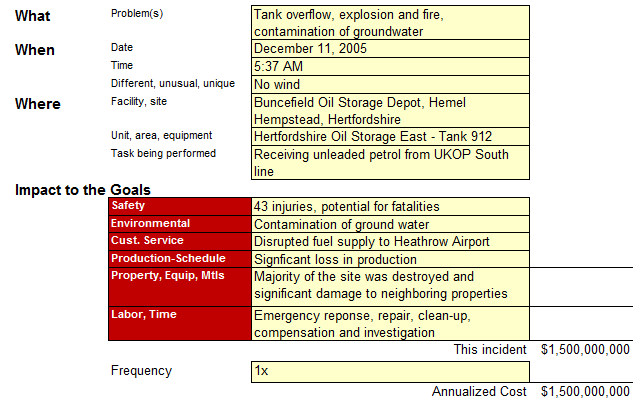
Step 2. Identify the Causes (The Analysis)
The analysis step is where the incident is broken down into causes which are captured on the Cause Map. The Cause Map starts by writing down the goals that were affected as defined in problem outline. For the explosion and fire at the Buncefield Storage Depot, the safety goal was impacted because of the 43 injuries and potential for fatalities. This is the first cause-and-effect relationship in the analysis.
The analysis can continue by asking Why questions and moving to the right of either of the cause-and-effect relationships above. In this example we’ll start with the 43 injuries and potential fatalities which were caused by the violent explosion and fire.
We continue to ask “Why” questions to develop the Cause Map. The explosion and initial fire were due to a large, butane vapor cloud.
Any fire requires heat, fuel and oxygen.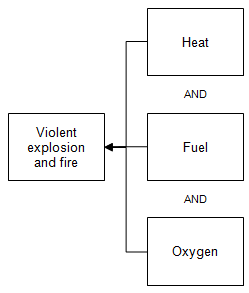
In this case, the heat source was suspected to be the fire water pump, which was started in response to the potential hazard of the vapor cloud. This cause was supported by witness statements.
Oxygen, sufficient for burning, is present in the atmosphere.
The fuel for the fire was the large butane vapor cloud. The source of the vapor cloud was a release of petrol due to overfilling a tank during a receipt of fuel.
The tank overfilled during the receipt of fuel because the operator was unaware of the high level in the tank. There was no audible alarm to warn the operator of the level reaching tank capacity and the operator had no anticipated fill time for comparison. This was due to the fact that the flowrate on the UKOP pipeline was controlled outside of the facility.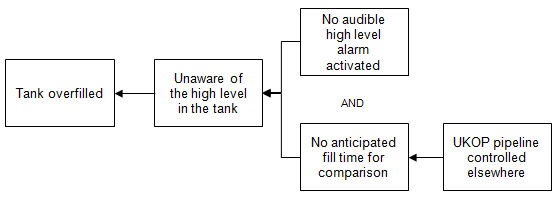
The level gauge on the tank had gotten stuck 2.5 hours prior to reaching the tank capacity. In addition, the independent high level switch (IHLS) also failed to operate. The IHLS was missing a padlock which was required to keep the lever in the operating position. Both of these instrument failures resulted in an absence of an audible high level alarm.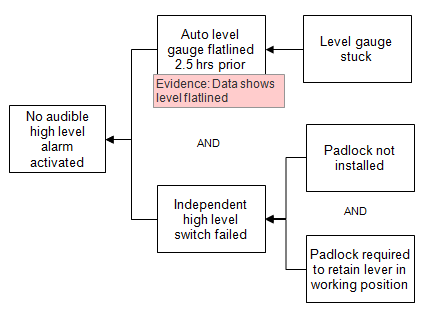
The violent explosion and fire resulted in significant damage to the facility, as well as to neighboring properties. The damage to the facility caused a shortage of fuel supply to Heathrow Airport, which received half of its daily fuel demand from the Buncefield Storage Depot.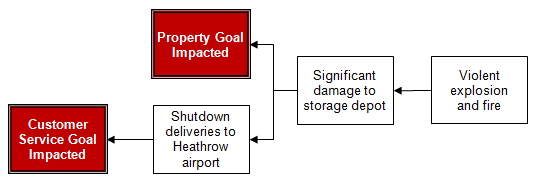
The loss of primary containment (the tank overfilling), as well as the use of fire suppression foam, resulted in material being in the secondary containment, called a bund. The bund leaked, resulting in contamination of the local groundwater table.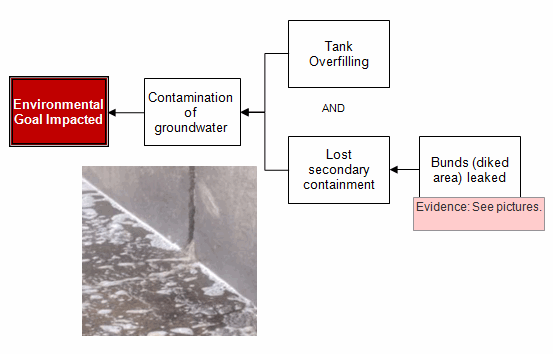
Step 3. Select the Best Solutions (Reduce the Risk)
Once the Cause Map is built to a sufficient level of detail with supporting evidence, it can be used to develop solutions. The Cause Map is used to identify all the possible solutions for a given issue so that the best solutions can be selected. It is easier to identify many possible solutions from the detailed Cause Map than an oversimplified high level analysis.
Solutions can be documented directly on the Cause Map. Solutions are typically placed in a green box directly above the cause the solution controls. At this stage, all solutions are considered and put on the Cause Map.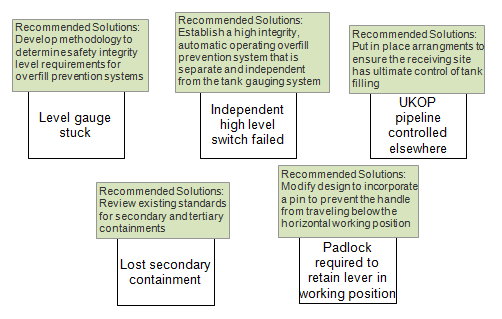
After the analysis is complete, the best solutions are selected based on the impacts to the organization’s goals. Shown below are a few of the solutions recommended as a result of this incident.
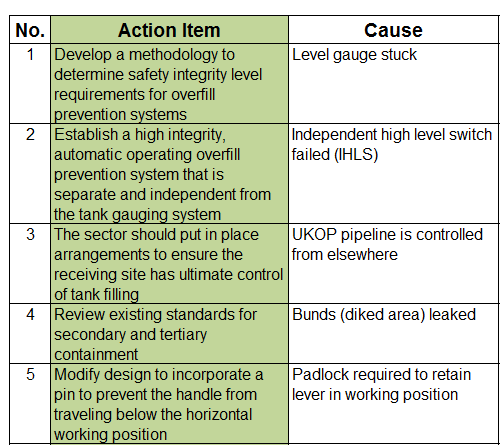
Cause Mapping Improves Problem Solving Skills
The Cause Mapping method focuses on the basics of the cause-and-effect principle so that it can be applied consistently to day-to-day issues as well as catastrophic, high risk issues. The steps of Cause Mapping are the same, but the level of detail is different. Focusing on the basics of the cause-and-effect principle make the Cause Mapping approach to root cause analysis a simple and effective method for investigating safety, environmental, compliance, customer, production, equipment or service issues. ”
Click on “Download” above to download a PDF showing the Root Cause Analysis Investigation.
Bring Cause Mapping® Root Cause Analysis training to your site
Schedule a workshop at your location to train your team on how to lead, facilitate, and participate in a root cause analysis investigation.
